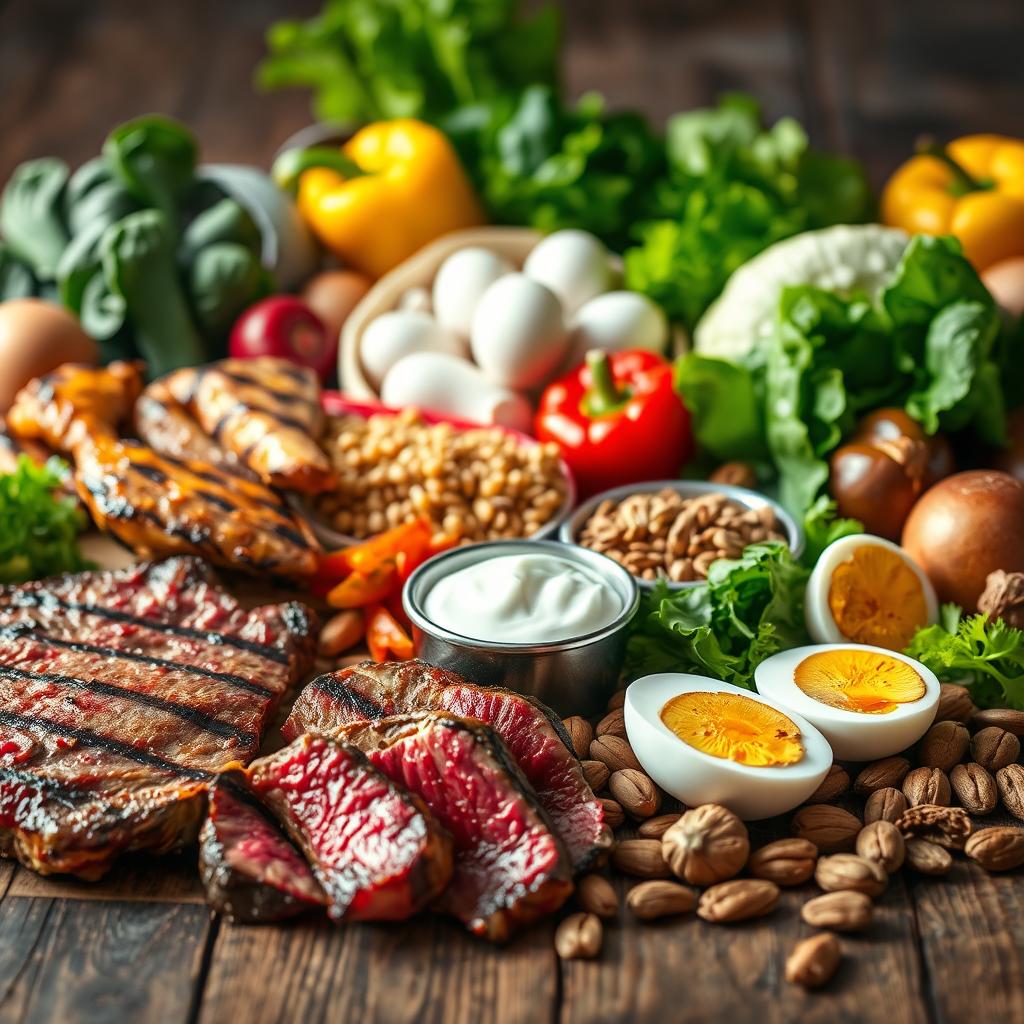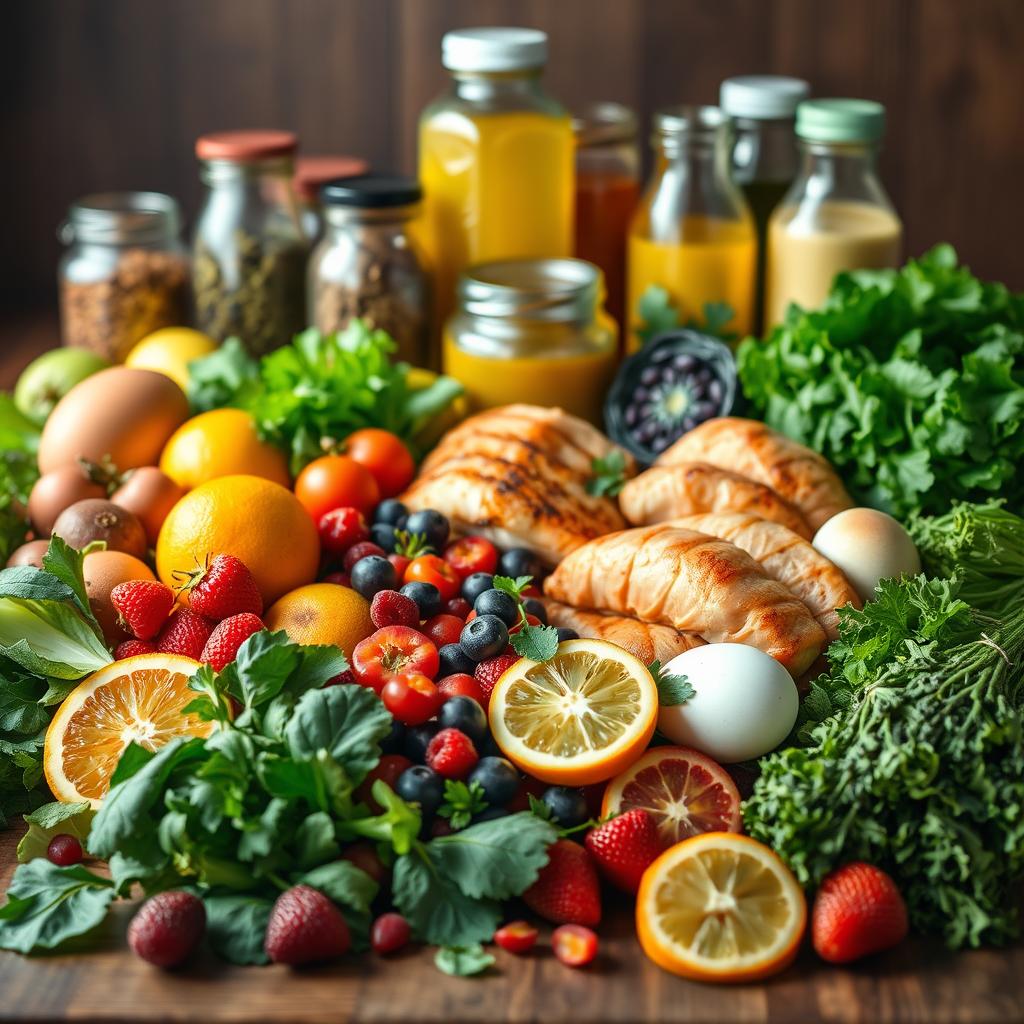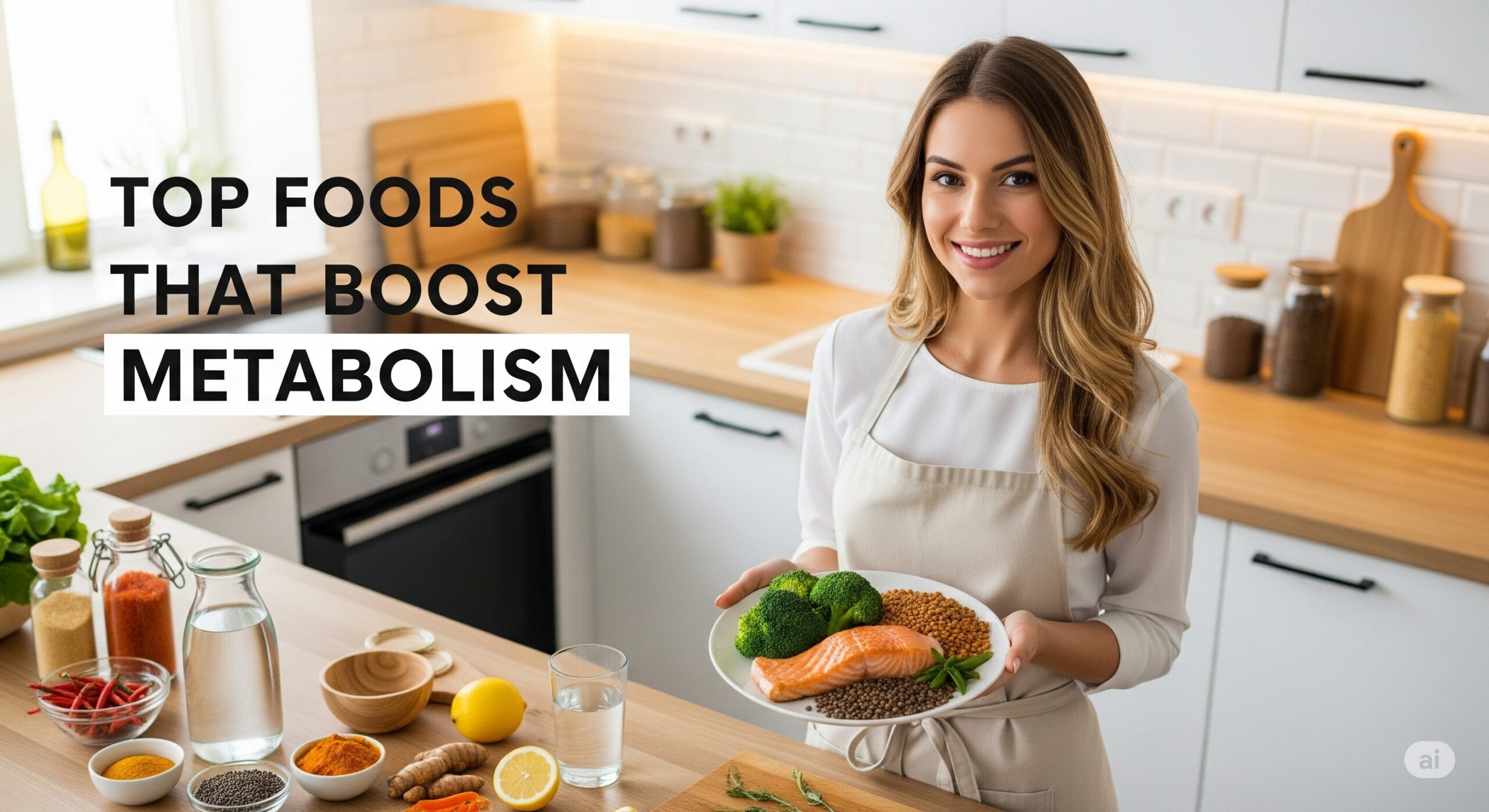Foods That Boost Metabolism
Your metabolism is like your body’s engine, turning what you eat into energy. While genetics and aging play a role, you’re not stuck with a sluggish system. Simple changes in your diet can make a big difference…like eating Foods That Boost Metabolism
Think of it this way: Grandma’s slow metabolism doesn’t have to be your destiny. With the right choices, you can keep your energy levels high and support your overall health. And yes, it’s easier than you might think.
From protein-packed salmon to nutrient-rich greens, certain foods can help rev up your system. These aren’t magic bullets, but they’re science-backed helpers that work best alongside exercise and smart habits. Ready to learn more? Let’s get started.
For a deeper dive into how nutrients like B vitamins and magnesium support your system, check out this helpful guide.
What is Metabolism and Why Does It Matter?
Think of your metabolism as a team of superheroes working to keep you energized. It’s the process your body uses to convert food into the energy needed for everything from breathing to running a marathon. Without it, even the simplest tasks would feel impossible.
Understanding the Basics of Metabolism
Your liver, muscles, and brain are like the Avengers of your body. They work together to keep your metabolism running smoothly. The liver processes nutrients, muscles burn calories, and the brain ensures everything stays in balance.
Here’s a fun fact: muscle mass burns more calories than fat, even at rest. Pound for pound, muscle is like a Tesla—efficient and always on. That’s why strength training is a game-changer for your metabolism.
How Metabolism Affects Weight Loss and Overall Health
Your chair might be comfy, but it’s also a metabolic wet blanket. Sedentary lifestyles slow down your metabolism, making weight loss harder. The good news? Small changes, like standing more or adding short walks, can reignite your calorie-burning campfire.
Success stories show that boosting your metabolism doesn’t require extreme measures. Consistency with simple habits can lead to big results over time.
| Body Composition | Calories Burned at Rest (per pound) |
|---|---|
| Muscle Mass | 6 calories |
| Fat | 2 calories |
Top Foods That Boost Metabolism Naturally
Ever wondered how your plate can power up your energy levels? Certain choices can make a big difference in how your body processes fuel. Let’s explore three categories that naturally rev up your system.

Protein-Rich Options: Lean Meats, Fish, and Legumes
Protein-rich options like salmon, chicken breast, and black beans are metabolic MVPs. They require more energy to digest, which can increase your metabolic rate. Plus, they keep you full longer, making them a win-win for your energy and appetite.
Pro tip: Transform canned beans into a quick, nutrient-packed meal. Who knew pantry staples could be this powerful?
Spicy Additions: Chili Peppers and Capsaicin
Spicy additions like chili peppers can turn meals into mini sauna sessions. The compound capsaicin temporarily increases calorie burn by raising your body temperature. It’s like sweating your way to a more energetic you.
High-Fiber Choices: Broccoli, Lentils, and Oatmeal
High-fiber choices like broccoli and lentils keep your gut busy burning calories. They also slow down sugar release into your bloodstream, promoting sustained energy. For a tasty combo, try tuna-stuffed avocados or lentil taco nights.
For more tips on nutrient-packed meals, check out this helpful guide.
How Protein-Rich Foods Increase Metabolic Rate
Ever noticed how a steak meal leaves you warmer than a pasta dish? That’s protein at work. It revs up your metabolic rate by making digestion a calorie-burning workout. Think of it as a tax your body charges for processing nutrients—protein has the highest rate.

The Thermic Effect of Food (TEF)
Protein’s magic trick? Its thermic effect is 15–30%, meaning 30% of its calories burn during digestion. Carbs and fats? Just 5–10%. Digesting a 3oz chicken breast (27g protein) torches calories like a brisk walk.
Examples of High-Protein Metabolism-Boosting Foods
Not all proteins are created equal. Here’s how to pick winners:
- Greek yogurt parfaits: Tastes like dessert but fuels your metabolic rate with 15g protein per serving.
- Tempeh stir-fry: Plant-powered protein (20g per cup) keeps vegetarian diets firing on all cylinders.
- Budget heroes: Frozen shrimp and canned tuna pack 20g protein per dollar at Costco.
| Nutrient | Thermic Effect (%) | Calories Burned per 100g |
|---|---|---|
| Protein | 15–30% | 25–50 |
| Carbs | 5–10% | 5–10 |
| Fats | 0–3% | 0–3 |
Pro tip: Calculate your daily protein goal by multiplying your weight in kg by 0.8. A 150lb (68kg) person needs ~54g—about two chicken breasts or three cups of lentils.
The Role of Spices in Revving Up Your Metabolism
Spices aren’t just for flavor—they’re secret weapons for your energy levels. From the heat of chili peppers to the soothing warmth of ginger, these kitchen staples can do more than make your meals taste great. They can also help burn calories and keep your system running smoothly.

Capsaicin: The Heat Behind Chili Peppers
Ever wondered why spicy food makes you sweat? That’s capsaicin, the compound in chili peppers that turns up the heat. Research shows that just 2mg of capsaicin before a meal can reduce calorie intake and rev metabolism. It’s like turning your dinner into a mini workout.
Pro tip: Add a pinch of cayenne to your chocolate smoothie for a surprising kick. Or, sprinkle it on scrambled eggs for a breakfast that wakes up your taste buds and your energy levels.
Ginger and Other Metabolism-Boosting Spices
Ginger is nature’s multitasker. It settles your stomach while increasing calorie burn by up to 43%. Plus, it’s easy to incorporate into your meals. Try grating fresh ginger into your tea or adding it to stir-fries for a zesty twist.
Here are a few more ways to spice things up:
- Turmeric: Add it to scrambled eggs or roasted veggies for a golden glow and a metabolic boost.
- Cinnamon: Sprinkle it on oatmeal or yogurt for a sweet, warming treat.
- Spice blends: Whip up your own mix of cayenne, paprika, and garlic powder for lazy cooks who want big flavor.
Surprising research shows that occasional spice eaters get even bigger metabolic boosts. So, don’t be afraid to turn up the heat every now and then.
Hydration and Metabolism: The Power of Water
Water isn’t just for quenching thirst—it’s a silent partner in your body’s energy game. Staying hydrated helps your system run efficiently, from burning calories to maintaining energy levels. And yes, even a glass of cold water can make a difference.

How Drinking Water Supports Metabolism
Your body uses water to process nutrients and convert food into fuel. Cold water, in particular, can burn calories as your body works to warm it up—about 8 calories per glass. It’s like turning your drink into a mini workout.
Pro tip: Start your day with a glass of lemon water. It kickstarts your metabolism better than coffee and keeps you hydrated from the get-go.
Tips for Staying Hydrated Throughout the Day
Here are some easy ways to keep your hydration game strong:
- Ice water hacks: Think of it as AC for your metabolic engine. The colder, the better.
- Calculate your needs: Divide your weight in pounds by 2 to find your daily ounces. For example, a 150lb person needs 75oz.
- Flavor twists: Add cucumber, mint, or lemon to your water for a refreshing twist.
- Tech tricks: Use smart bottles that glow when you’re behind on hydration.
| Hydration Tip | Benefit |
|---|---|
| Ice Water | Burns 8+ calories per glass |
| Lemon Water | Kickstarts metabolism |
| Flavor Infusions | Makes hydration enjoyable |
Foods That Support Thyroid Function and Metabolism
Your thyroid works like a thermostat for your energy levels—here’s how to fuel it right. Tiny but mighty, this gland relies on key nutrients to keep your metabolism humming. Skip the guesswork with these science-backed picks.

Iodine-Rich Foods: Seaweed and Dairy
Iodine is your thyroid’s best friend. Seaweed snacks or sushi rolls wrapped in nori deliver a mega dose. Not a fan of ocean flavors? Greek yogurt and cottage cheese are land-based alternatives.
Pro tip: Transform nori sheets into crunchy wraps with avocado and smoked salmon. Thyroid support never tasted so good.
Selenium Sources: Nuts, Seeds, and Legumes
Brazil nuts are nature’s selenium supplements—just two a day cover your needs. Lentils and sunflower seeds offer plant-powered alternatives. Bonus: they’re budget-friendly and shelf-stable.
For more on thyroid-friendly diets, check the Mayo Clinic’s guide.
- Thyroid tune-up: Swap soda for kombucha with ginger—fermented drinks support gut-thyroid connections.
- Warning: Walnuts and raw cruciferous veggies in excess can interfere with thyroid function. Balance is key.
Incorporating Metabolism-Boosting Foods into Your Diet
Your kitchen can be your secret weapon for staying energized all day. With a few smart choices, you can turn your meals and snacks into tools that keep your body running smoothly. Let’s break it down into simple, actionable steps.

Meal Planning Tips for Weight Loss
Planning your meals doesn’t have to be boring—it can be a game-changer. Start by batch-cooking chili with three bean varieties. This not only saves time but also provides lasting metabolic benefits. For busy days, turn Chipotle bowls into metabolism power meals by adding extra beans and veggies.
Here are a few more ideas to keep your meals on track:
- Budget-friendly options: Create $5/day meal plans featuring eggs, beans, and frozen veggies.
- Family-friendly swaps: Sneak lentils into meatloaf or cauliflower into mashed potatoes for a nutrient boost.
- Protein-packed breakfasts: Try overnight oats with chia seeds for 10g of protein to start your day strong.
Healthy Snack Ideas to Keep Your Metabolism Active
Snacks don’t have to derail your goals—they can actually keep your energy levels steady. Keep wasabi peas and spicy roasted chickpeas on hand for crunch cravings. These options are not only tasty but also help keep your system active.
Here are some other snack ideas to try:
- Cottage cheese + berries: A simple combo that packs 20g of protein.
- Greek yogurt parfaits: Add nuts and a drizzle of honey for a sweet treat.
- Spicy nuts: A handful of chili-spiced almonds can give your metabolism a little kick.
For more tips on creating a diet that supports your energy levels, check out this helpful guide.
Your Path to a Healthier, More Energetic You
Small changes today can spark big energy tomorrow—let’s make them stick. Sustainable weight loss isn’t about extremes; it’s about balancing protein-packed meals with strength training. Think of muscle as your metabolic savings account—the more you invest, the higher your returns.
Track progress beyond the scale. Notice how your jeans fit or how your energy lasts through afternoon meetings. Celebrate non-scale wins like lifting heavier groceries or craving spicy snacks (thank you, capsaicin!).
Holidays? No panic. Maintenance mode means extra walks and smart swaps—turkey over pie, sparkling water over soda. Your metabolism won’t quit if you don’t.
Ready to boost metabolism naturally? Pair these tips with 10-minute strength routines. Your future self—vibrant, strong, and full of life—will thank you.
📚 References for Foods That Boost Metabolism
- Acheson, K. J., et al. (2011). Protein choices targeting thermogenesis and metabolism. Am J Clin Nutr, 93(3), 525–534.
- Johnston, C. S., et al. (2006). Thermic effect of food, meal frequency, and energy balance. Obesity (Silver Spring), 14(4), 646–655.
- Westerterp-Plantenga, M. S., et al. (2009). Dietary protein—its role in satiety, energetics, weight loss and health. Br J Nutr, 101(6), 998–1006.
- Ludy, M. J., et al. (2012). The effects of capsaicin and capsiate on energy balance: critical review and meta-analyses. Chem Senses, 37(2), 103–121.
- Henry, C. J., et al. (2015). Ginger consumption enhances the thermic effect of food and promotes feelings of satiety. Metabolism, 61(10), 1347–1352.
- Boschmann, M., & Steiniger, J. (2003). Water-induced thermogenesis. J Clin Endocrinol Metab, 88(12), 6015–6019.
- Zimmermann, M. B., et al. (2008). Iodine-deficiency disorders. Lancet, 372(9645), 1251–1262.
- Combs, G. F. Jr. (2001). Selenium in global food systems. Annu Rev Nutr, 21, 453–473.
- National Institutes of Health (NIH). (2022). Dietary Supplements: Iodine.
- Hursel, R., & Westerterp-Plantenga, M. S. (2010). Thermogenic ingredients and body weight regulation. Int J Obes (Lond), 34(4), 659–669.
- Dulloo, A. G., & Schutz, Y. (2015). Adaptive thermogenesis in resistance to obesity therapies. Am J Clin Nutr, 102(4), 807–819.
